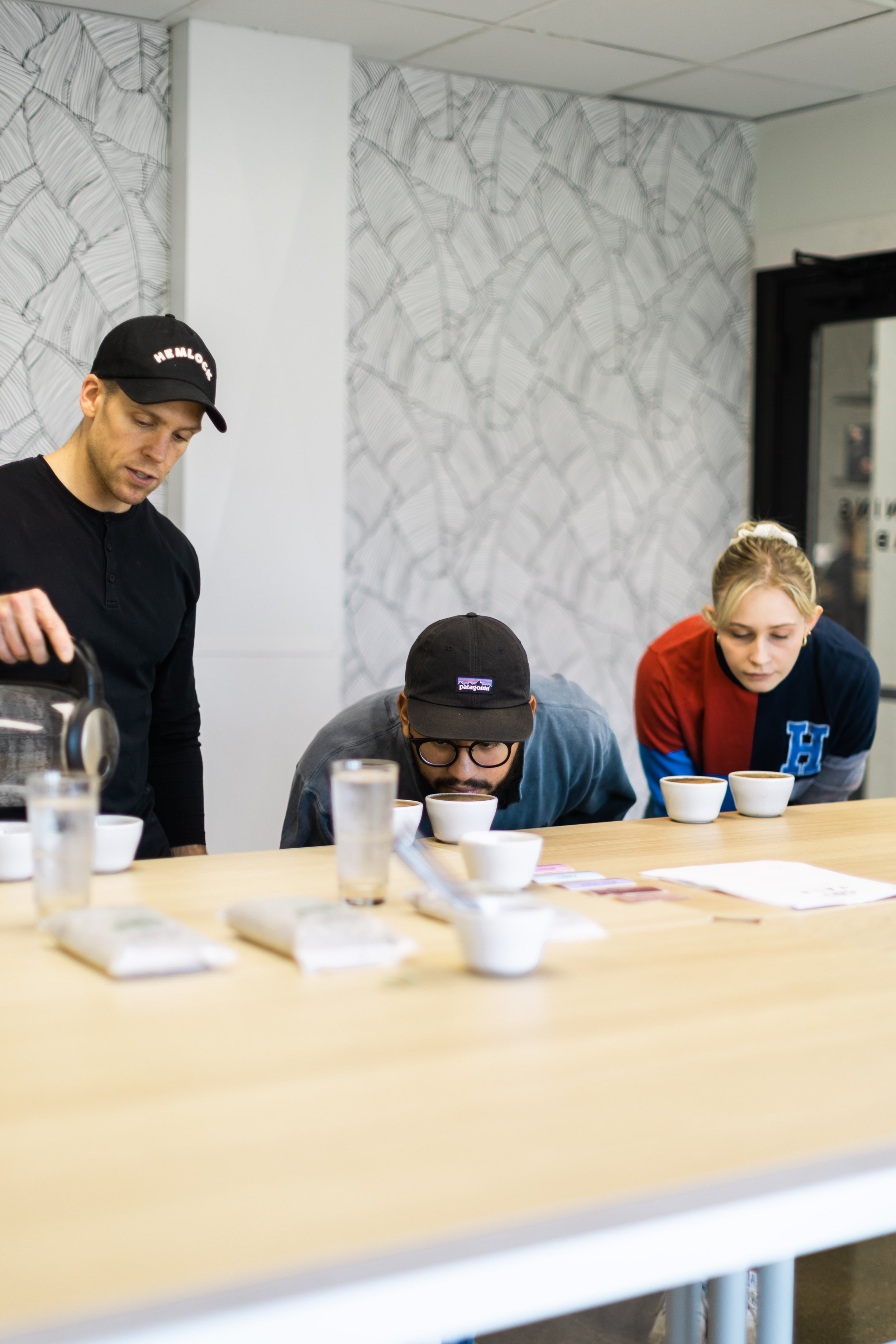How Do I Get Better at Tasting Coffee?
If you’ve ever taken a sip of coffee and wondered how some people can pick out tasting notes like peach, jasmine, and caramelized sugar, you’re not alone. Tasting coffee is a skill — one that develops over time.
1. Slow down and pay attention
Most of us drink coffee while multitasking — answering emails, driving, or getting the kids out the door. When you really want to pay attention to how coffee tastes, you’ll need to slow down and pay attention. As you get more accustomed to tasting, you will find it easier to focus even amidst the distractions, but to start out, you might need to set aside an intentional moment.
We take all our employees through training that includes cupping all of our current coffee offerings. Cupping is a process (kind of like wine-tasting) that allows you to efficiently taste several coffees side-by-side. Tasting coffee in this way is a really helpful way to start understanding what you’re tasting in your cup of coffee, but you can also begin to slow down and pay attention as you sip your coffee at home, too!
2. Start general
We always tell our team members in these trainings to begin in the most general terms: do you like it or dislike it? The first few times, that might be all you identify. Eventually, you can start to identify other broad categories (fruity, floral, sweet, chocolate-y). If you identify that a coffee tastes sort of fruity, you can think about what general type of fruit you taste–does it taste like citrus, berries, stone fruit, or tropical fruit, for instance. If you think you’re tasting stone fruit, would you say it leans more towards a plum or an apricot, or something else? This general-to-specific way of approaching the taste is super helpful even for those with more advanced palates. The Specialty Coffee Association has a Coffee Taster’s Wheel that does a beautiful job of representing this move from broad categories to more specific elements. We have the poster hanging in our Training Lab, and use it for reference when we’re cupping coffees.
3. Taste side by side
One of the best ways to sharpen your palate is to compare two coffees at once. Brew them both the same way (same ratio, same method), then taste them back-to-back. You’ll notice differences much more easily. As opposed to thinking from “scratch,” you are comparing the two. Which one tastes more fruity? Which tastes sweeter? Which tastes more chocolate-y? This helps immensely and usually results in pinpointing more specific flavors.
4. Keep a tasting journal
Even a few quick notes — the coffee name, brew method, and what you noticed — can go a long way. Over time, you’ll start to recognize trends: maybe you always love washed Ethiopian coffees, or you tend to enjoy lighter roasts with floral notes. Your notes can help you find more coffees you love. We stock a Coffee Journal that has space for you to examine a coffee, determine tasting notes, and give your overall impressions. This helps kill two birds with one stone — helping you set aside time and attention while also giving you a way to keep track of your thoughts.
5. Join a cupping or tasting
Join us for a Roastery Tour & Cupping where you’ll see how a batch of coffee is roasted and walk through a full coffee cupping with Keith. This is the same process we go through with training our staff, but given in a way anyone can understand and enjoy. See how the coffee is roasted, and get some insight into how to identify what you’re tasting.
Take it further
Last year at the SCA Expo in Chicago, we attended a breakout session introducing the new Coffee Value Assessment tool that was recently adopted across the industry. This standardization is super important for the industry–this is how coffees get graded and priced at origin, for instance–but it is way more than you need for your own personal enjoyment of coffee. As with everything in coffee, you can take it into the nitty-gritty nerdy territory, or keep it at an approachable level. If you want to dive into that nerdy side, reading about the new CVA tool will definitely spark your interest and open you up to the intricate world of coffee tasting. But remember, the goal of tasting coffee is to enjoy it even more, however that works for you!
The bottom line
Getting better at tasting coffee isn’t about memorizing flavor wheels or mastering the perfect vocabulary — it’s about curiosity. The more coffees you taste, the more connections your palate will make. The goal isn’t to “get it right,” but to get more out of every cup.
Joanna Tong
Joanna is one of the owners here at Tala, heading up Operations and Strategy. Born and raised in Minnesota, she moved to Illinois in 2014 with no intention of staying long-term until the idea of Tala came to light. When not in the office or the cafe, you can find her in a forest preserve enjoying the outdoors or at home hanging out with her cat.



